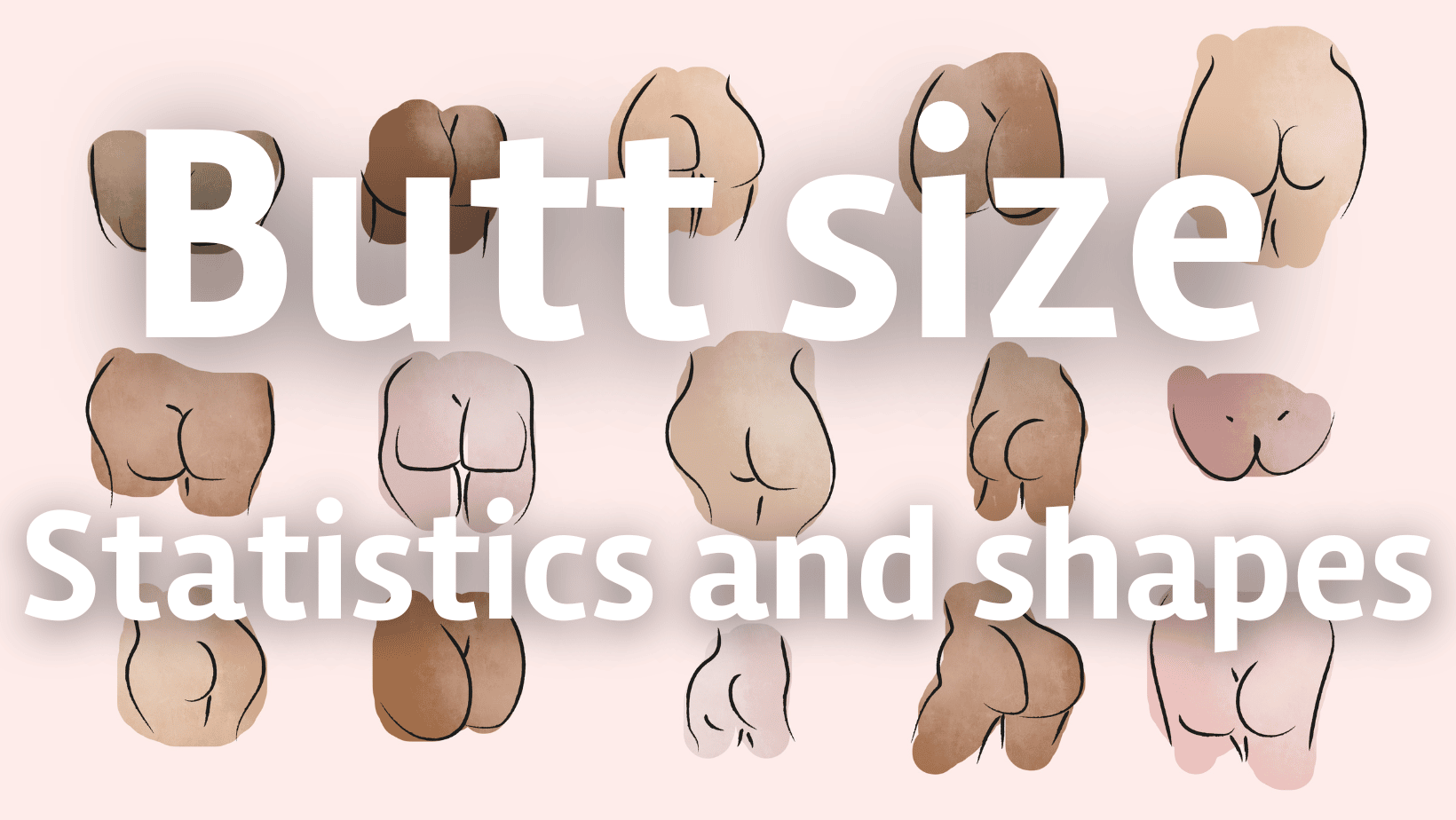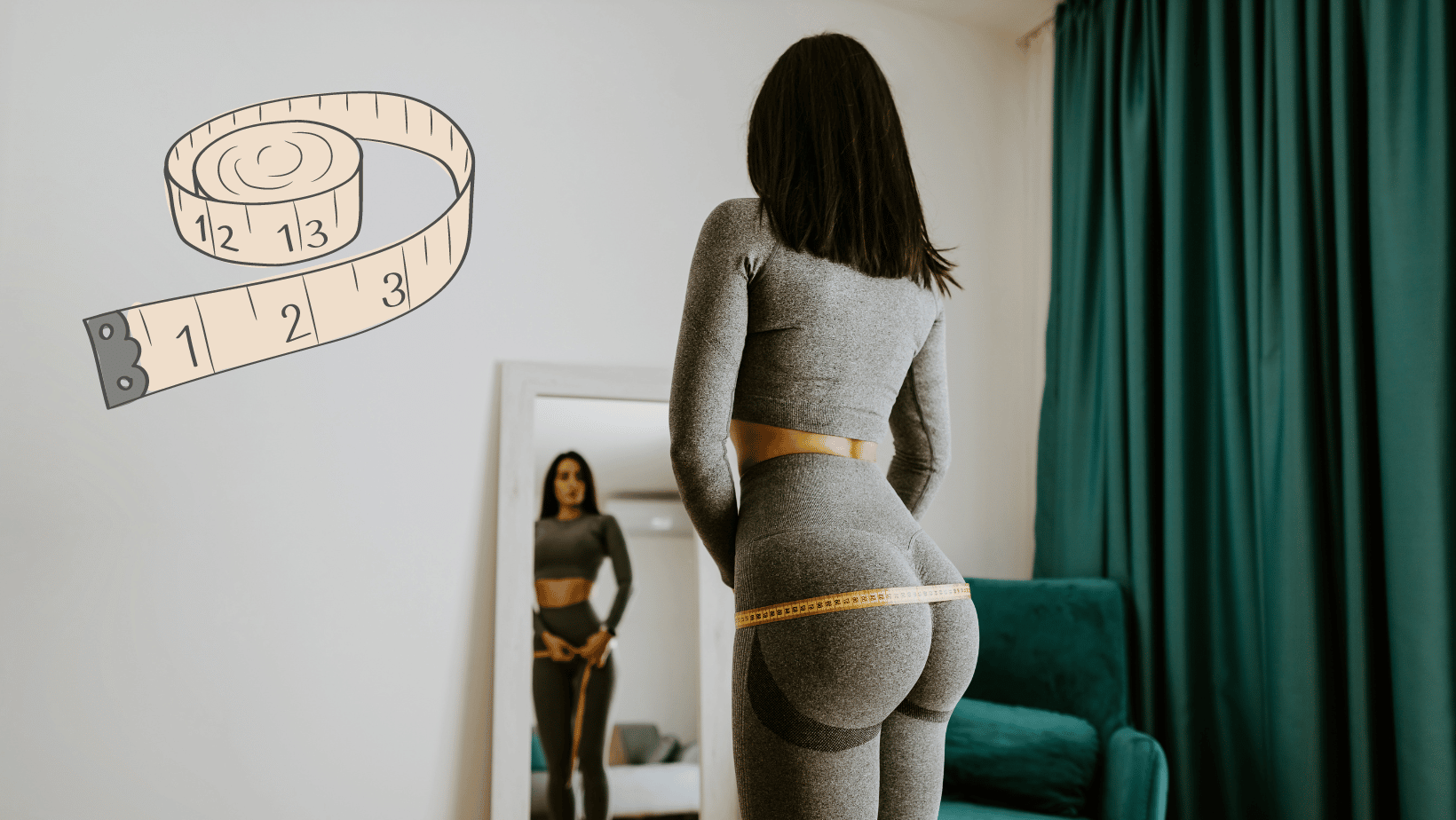
Celebrating the Diversity of Human Buttocks: Bedbible Research Center’s ‘Butt Size Chart Statistics’ offers a captivating glimpse into the varied world of butt sizes and shapes. This study, devoid of self-reported biases, is based on objective measurements from a large and diverse group. It highlights the fascinating differences and trends in butt sizes across different demographics, providing a unique perspective on this often-discussed aspect of human anatomy. Dive into this report for an enlightening journey through the world of buttocks sizes – a topic that combines cultural, aesthetic, and anatomical interests.
Here’s what we’ve covered:
- Average butt size by age and gender
- Other ways to measure butt sizes than circumference
- What Did Other Studies Find
- The 8 Different Butt Shapes (types of butts)
- Human anatomy factors that affect butt shapes
- Historic aspirations for ideal butt sizes
- Butt size fun facts
Key Statistics
- Men on average have a butt size of 38.17 inches (in circumference)
- Women on average have a butt size of 40.16 inches (in circumference)
- Women on average have a larger butt than men (2.5 inches more in circumference)
- White men on average have a bigger butt (39.37 inches in circumference) than any other race (black men = 38.09 inches, Hispanic men = 40.39 inches)
- Black females on average have a bigger butt (41.85 inches in circumference) than any other race (white females = 40.12 inches, Hispanic females = 40.39 inches)
- A small butt for women (smallest 25%) is considered to be under 93.6 inches in circumference, while a large (biggest 25%) is over 42.56 inches.
- A small butt for men (smallest 25%) is considered to be under 93.8 inches in circumference, while a large (biggest 25%) is over 40.94 inches.
- The ideal butt size was very small during the 1950s and 1960s and in the Victorian era and Ancient Greece.
Average butt size by age and gender
By using anthropometric data on the circumference of the largest section of the butt we categorized the data by gender, age, and race.
Here are a few interesting tabulations:
Male, by age groups
| Age Group | N | Mean (in) | Smallest 5% (in) | Smallest 25% (in) | Biggest 25% (in) | Biggest 5% (in) |
|---|---|---|---|---|---|---|
| 20–29 years | 1578 | 38.38 | 33.50 | 35.87 | 40.12 | 45.00 |
| 30–39 years | 1428 | 39.21 | 34.57 | 36.85 | 40.91 | 45.91 |
| 40–49 years | 1174 | 39.64 | 34.13 | 37.20 | 41.46 | 46.46 |
| 50–59 years | 817 | 39.80 | 34.92 | 37.83 | 41.42 | 45.75 |
| 60–69 years | 1103 | 39.61 | 34.76 | 37.48 | 41.54 | 44.88 |
| 70–79 years | 772 | 39.21 | 34.41 | 36.89 | 40.98 | 45.31 |
| > 80 years | 539 | 38.39 | 34.06 | 36.30 | 40.12 | 43.90 |
| Total | 7411 | 39.17 | 34.33 | 36.93 | 40.94 | 45.31 |
Female, by age groups
| Age Group | N | Mean (in) | Smallest 5% (in) | Smallest 25% (in) | Biggest 25% (in) | Biggest 5% (in) |
|---|---|---|---|---|---|---|
| 20–29 years | 1616 | 38.66 | 33.15 | 35.59 | 40.67 | 47.36 |
| 30–39 years | 1699 | 40.43 | 33.98 | 36.81 | 42.95 | 50.59 |
| 40–49 years | 1299 | 40.94 | 34.49 | 37.52 | 43.35 | 50.59 |
| 50–59 years | 962 | 41.50 | 34.80 | 37.80 | 44.29 | 52.13 |
| 60–69 years | 1076 | 40.59 | 34.33 | 37.24 | 43.03 | 49.61 |
| 70–79 years | 854 | 39.92 | 34.13 | 36.65 | 42.32 | 48.46 |
| > 80 years | 562 | 39.13 | 33.54 | 36.42 | 41.42 | 46.57 |
| Total | 8068 | 40.16 | 34.06 | 36.85 | 42.56 | 49.33 |
Under 20 years old
| Age (years) | N, male | Mean, male (in) | N, female | Mean, female (in) |
|---|---|---|---|---|
| 2 | 524 | 20.08 | 508 | 20.00 |
| 3 | 484 | 20.63 | 560 | 20.75 |
| 4 | 540 | 21.50 | 525 | 21.97 |
| 5 | 491 | 22.56 | 556 | 23.00 |
| 6 | 278 | 24.02 | 273 | 23.98 |
| 7 | 268 | 25.24 | 268 | 25.67 |
| 8 | 260 | 26.69 | 244 | 27.32 |
| 9 | 273 | 28.46 | 272 | 28.66 |
| 10 | 293 | 29.33 | 255 | 29.84 |
| 11 | 280 | 30.79 | 267 | 31.97 |
| 12 | 202 | 32.52 | 233 | 33.66 |
| 13 | 181 | 33.58 | 218 | 35.83 |
| 14 | 185 | 35.75 | 217 | 36.97 |
| 15 | 181 | 36.42 | 188 | 36.77 |
| 16 | 191 | 36.69 | 204 | 37.64 |
| 17 | 191 | 37.40 | 193 | 38.43 |
| 18 | 169 | 37.28 | 169 | 37.72 |
| 19 | 161 | 37.80 | 170 | 38.43 |
Butt size by race
| Male | N | Mean (in) | Smallest 5% (in) | Smallest 25% (in) | Biggest 25% (in) | Biggest 5% (in) |
|---|---|---|---|---|---|---|
| Non-Hispanic white | 3020 | 39.37 | 34.53 | 37.09 | 41.18 | 45.55 |
| Non-Hispanic black | 1973 | 39.09 | 33.54 | 36.26 | 41.22 | 46.42 |
| Mexican American | 2145 | 38.31 | 33.70 | 36.14 | 40.00 | 44.21 |
| All | 7411 | 39.21 | 34.17 | 36.85 | 41.02 | 45.55 |
| Female | N | Mean (in) | Smallest 5% (in) | Smallest 25% (in) | Biggest 25% (in) | Biggest 5% (in) |
|---|---|---|---|---|---|---|
| Non-Hispanic white | 3394 | 40.12 | 34.09 | 36.69 | 42.52 | 49.25 |
| Non-Hispanic black | 2299 | 41.85 | 34.09 | 37.80 | 44.68 | 52.56 |
| Mexican American | 2022 | 40.39 | 34.06 | 37.01 | 42.91 | 49.61 |
| All | 7715 | 40.78 | 34.09 | 37.17 | 43.39 | 50.47 |
Other ways to measure butt sizes than circumference
Butt size is a topic that has recently gained a lot of attention in the media and popular culture. Many people are curious about what constitutes a “normal” butt size and how it can be measured apart from the butt circumference.
Method 1: HWR-method
One way to measure butt size is by using the Hip-to-Waist Ratio (HWR) method. The HWR is calculated by dividing the measurement of a person’s hips by the measurement of their waist. A HWR of 0.8 – 1.0 is considered to be within the normal range for women, while a HWR of 0.9 – 1.1 is considered to be within the normal range for men.
Method 2: BMI Scale
Another way to measure butt size is by using the Body Mass Index (BMI) scale. The BMI scale is a tool that uses a person’s weight and height to determine their level of body fat. Which then could be used as an indicator of butt size. However, BMI is mostly a good tool on a general (aggregate data) level. It is not a good predictor of individual butt sizes, but a great indicator to predict the average butt size of a large group of people (over 30). On the BMI scale, a butt size is considered to be within the normal range if it falls between 18.5 and 24.9.
Here is a chart that shows the different ranges of butt sizes based on the circumference, HWR, and BMI
| Butt Size | Circumference Women (in) | Circumference Men (in) | BMI Range | HWR Range (Women) | HWR Range (Men) |
|---|---|---|---|---|---|
| Small | Under 36.85 | Under 36.90 | Under 18.5 | Under 0.8 | Under 0.9 |
| Normal | 36.86 – 42.5 | 93.91 – 40.9 | 18.5-24.9 | 0.8 – 1.0 | 0.9 – 1.1 |
| Large | 42.51 or higher | 40.91 or higher | Over 25 | 1.1 or higher | 1.2 or higher |
It’s important to note that these measurements are not the only way to determine butt size and it’s not a definitive way to determine attractiveness or health. Everyone’s body is unique, and there is no such thing as a “perfect” butt size. Every body shape is beautiful in its way.
In conclusion, whether you have a small, normal, or large butt size, it’s important to remember that your worth as a person is not determined by your physical appearance. It’s important to focus on being healthy and happy rather than obsessing over the size of your butt.
What Did Other Studies Find

The size and shape of the human gluteal region, commonly referred to as the “butt,” has been a topic of interest in both popular culture and scientific research. The gluteal region is composed of the gluteus maximus, gluteus medius, and gluteus minimus muscles, as well as subcutaneous adipose tissue. The size and shape of the gluteal region can be influenced by a variety of factors, including genetics, body composition, and physical activity levels.
A study conducted by researchers at the University of Pittsburgh in 2018 found that the average circumference of the gluteal region in adult women was 38.7 inches, while the average circumference in adult men was 41.85 inches. The study also found that the average height and weight of participants were 64.02 inches and 63.7 kilograms for women, and 69.88 inches and 81.6 kilograms for men, respectively.
Another study, conducted by researchers at the University of Texas in 2019, found that the hip-to-waist ratio (HWR) was a significant predictor of gluteal size in both men and women. The study found that, on average, women had a HWR of 0.8, while men had a HWR of 0.9. The study also found that individuals with an HWR of less than 0.8 for women and less than 0.9 for men were considered to have a “normal” gluteal size, while those with an HWR greater than these values were considered to have a larger gluteal size.
It is worth noting that these studies are not definitive and are conducted on a specific sample of the population, also the measurements used in these studies may not be the only way to determine butt size and it’s not a definitive way to determine attractiveness or health.
The 8 Different Butt Shapes
There are several different types of butt shapes that people can have. Here are a few of the most common:
- Round Butt / Bubble / O-shaped: This type of butt is evenly proportioned and has a full, round shape. It’s often considered to be the most “ideal” butt shape.
- Square Butt / H-shaped: This type of butt is characterized by a flat and wide appearance, with little definition in the curve of the hips.
- Heart-shaped Butt / A-shaped: This type of butt is smaller at the top and gradually widens at the bottom, giving it a heart-shaped appearance.
- Ape-shaped Butt: This type of butt is large and wide, with a flat and downward-facing shape.
- Pear-shaped Butt: This type of butt is wider at the bottom and narrower at the top, giving it a pear-shaped appearance.
- Sagging Butt: This type of butt is characterized by a drooping or loose appearance due to loss of muscle tone or excess fat.
- Asymmetrical Butt: This type of butt is characterized by one side being larger or differently shaped than the other.
- Inverted Butt / V-shaped: This type of butt shape will be fuller around the waist, and have less volume in the lower parts.
It’s important to note that many people’s butts may not fit into just one category, and that’s normal. The human body is diverse, and different factors such as genetics, weight, and body composition can contribute to the shape of one’s butt. As always, every body shape is beautiful in its way, and there is no such thing as a “perfect” butt shape.
It’s also worth mentioning that while everyone’s body is unique and different, diet and exercise can play a role in toning and shaping the glutes. If someone is looking to make changes to their glutes, it’s best to seek guidance from a professional trainer or nutritionist.
Human anatomy factors that affect butt shapes
3 elements play a factor in how your butt is shaped:
- Bones: thickness and structure
- Muscles: structure and prevalence
- Fat: placement and prevalence
Of course, many more factors could be mentioned (outside the human anatomy, that contribute to altering this).
- Exercise
- Diet
- Vitamin intake
- Water intake
- Age
- Gender
- Hormonal level
- Work
Historic aspirations for ideal butt sizes
There is some data available on the historical aspect of butt size aspirations. The ideal body shape and size have varied throughout history and across cultures.
In ancient Greece, for example, a smaller butt was considered more attractive, while in many African cultures, a larger and more pronounced butt is considered more attractive. In the West, the ideal butt size and shape have also changed over time.
In the Middle Ages, a full and rounded butt was considered desirable, while in the Victorian era, a smaller and more delicate butt was considered more attractive.
During the 1950s and 1960s, the ideal butt size in Western culture was smaller, and more emphasis was placed on having a slim and toned figure.
However, in the 1980s and 1990s, the trend shifted towards a more curvy figure, with a larger and rounder butt being considered more desirable.
The trend continued to the 21st century and popular culture and media have been promoting a bigger butt and hourglass figure as the ideal body shape for women.
It’s important to note that the ideal body shape and size can change over time and vary across cultures, and it’s not a definitive way to determine attractiveness or health. Every body shape is beautiful in its way, and it’s important to focus on being healthy and happy rather than obsessing over trying to achieve a certain body shape or size.
The ideal body shape and size have varied throughout history and across cultures. Here is a brief overview of some of the historical changes in ideal butt size aspirations:
| Period | Ideal Butt Size |
|---|---|
| Ancient Greece | Smaller |
| African cultures | Larger and more pronounced |
| Middle Ages | Full and Rounded |
| Victorian era | Smaller and delicate |
| 1950s and 1960s | Smaller and slim |
| 1980s and 1990s | Larger and rounder |
| 21st century | Bigger and hourglass |
Butt size fun facts
Here are a few interesting facts about butt sizes that you may find informative:
- The gluteus maximus muscle is the largest in the human body, and it’s responsible for the shape and size of the butt.
- The size and shape of the butt can be influenced by both genetics and lifestyle factors, such as diet and exercise.
- The gluteal muscles can be strengthened and toned through exercises such as squats, lunges, and deadlifts.
- A study published in the International Journal of Obesity found that people with a larger butt size tend to have a lower risk of heart disease and diabetes.
- A larger butt size is often associated with higher levels of estrogen, which is a hormone linked to fertility and overall health in women.
- In some cultures, a larger butt size is considered a sign of fertility and good health, and in some cultures, it’s considered a sign of wealth and status.
- There is a growing trend of people undergoing cosmetic procedures such as butt implants and Brazilian butt lifts to enhance their butt size and shape.
Here are a few lesser-known facts about butt sizes that may be considered more obscure or controversial:
- Some scientists believe that the size and shape of the butt may be an indicator of overall health and fitness. A study published in the American Journal of Human Biology found that people with a larger butt size tend to have lower levels of inflammation and better glucose metabolism, which are both markers of good health.
- Some researchers have suggested that the size and shape of the butt may be related to the ability to store fat. A study published in the journal PLOS One found that people with a larger butt size tend to have a higher capacity to store fat, which may be beneficial during times of food scarcity.
- Some experts believe that the size and shape of the butt may be related to intelligence. A study published in the journal Intelligence found that people with a larger butt size tend to have higher IQ scores.
- Some people believe that the size and shape of the butt may be related to sexual attraction. A study published in the journal Personality and Individual Differences found that men are more attracted to women with a larger and more pronounced butt size.
